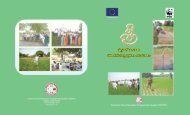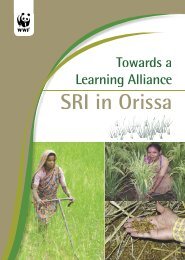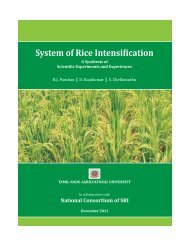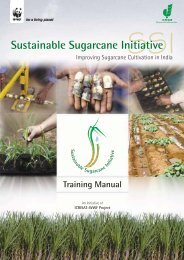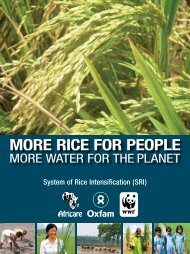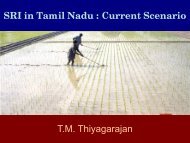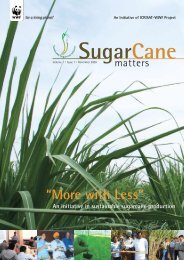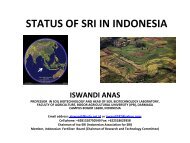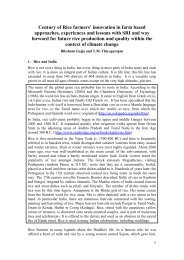Experiences of Farmers in India Experiences of Farmers in ... - AgSri
Experiences of Farmers in India Experiences of Farmers in ... - AgSri
Experiences of Farmers in India Experiences of Farmers in ... - AgSri
You also want an ePaper? Increase the reach of your titles
YUMPU automatically turns print PDFs into web optimized ePapers that Google loves.
Madhya Pradesh<br />
Fifth Step: Weed management, pest and disease control was done. Gundhi bug<br />
attack was seen <strong>in</strong> the field. Qu<strong>in</strong>alfas was applied to control this bug. Some plants<br />
were affected by Khaira disease which was controlled by apply<strong>in</strong>g Z<strong>in</strong>k Sulfate at<br />
the rate <strong>of</strong> 8 kg/acre.<br />
Traditional farm implements like plough, leveler and rope were used. Overall<br />
production was 13 q/acre.<br />
Innovations and modifications<br />
He was excited to adopt this method, because this was altogether a new experience<br />
to all <strong>of</strong> them. He used salt for seed treatment. This helped <strong>in</strong> remov<strong>in</strong>g poor quality<br />
seeds. Rais<strong>in</strong>g <strong>of</strong> nursery was first time done <strong>in</strong> his life. Dra<strong>in</strong>age l<strong>in</strong>e was prepared<br />
around the nursery bed for proper dra<strong>in</strong>age. Seed rate was very low compared to<br />
conventional method. Plant population was ma<strong>in</strong>ta<strong>in</strong>ed well.<br />
Benefits<br />
<br />
<br />
<br />
In conventional method, he used to use 30-35 kg <strong>of</strong> seeds. But <strong>in</strong> SRI, this<br />
quantity was reduced to 3-4 kg. This way he saved 30-32 kg <strong>of</strong> seeds per<br />
acre.<br />
In conventional method, plant to plant distance was very close thus number<br />
<strong>of</strong> tillers was less and weed was a major problem. But <strong>in</strong> SRI, he ma<strong>in</strong>ta<strong>in</strong>ed<br />
distance <strong>of</strong> 25 cm by 25 cm, therefore he could save time, money and labour<br />
also. Weeds were less and weed<strong>in</strong>g became easy.<br />
Overall, production from conventional method was only 6-7 q/ acre while <strong>in</strong> SRI<br />
it went up to 13-14 q/acre which was quite high <strong>in</strong> his area.<br />
Constra<strong>in</strong>ts <strong>in</strong> adoption<br />
Ma<strong>in</strong> constra<strong>in</strong>t faced while adopt<strong>in</strong>g SRI was ma<strong>in</strong>ta<strong>in</strong><strong>in</strong>g plant to plant and row<br />
to row distance. <strong>Farmers</strong> were not ready to adopt it completely. They managed<br />
distance accord<strong>in</strong>g to their understand<strong>in</strong>g.<br />
Lessons learnt<br />
<br />
<br />
Prepar<strong>in</strong>g nursery was completely a new learn<strong>in</strong>g for him. Before that he had<br />
never done this way <strong>in</strong> his field.<br />
Seed treatment us<strong>in</strong>g Trychoderma was done first time <strong>in</strong> his life. To remove<br />
poor quality seeds, salt treatment was done which was also new to him.<br />
50



